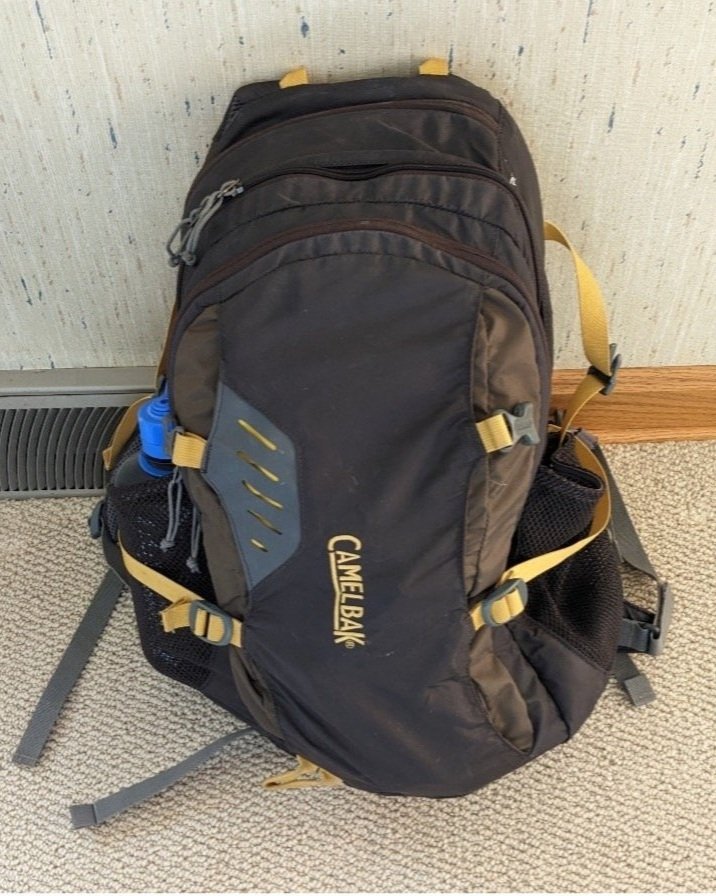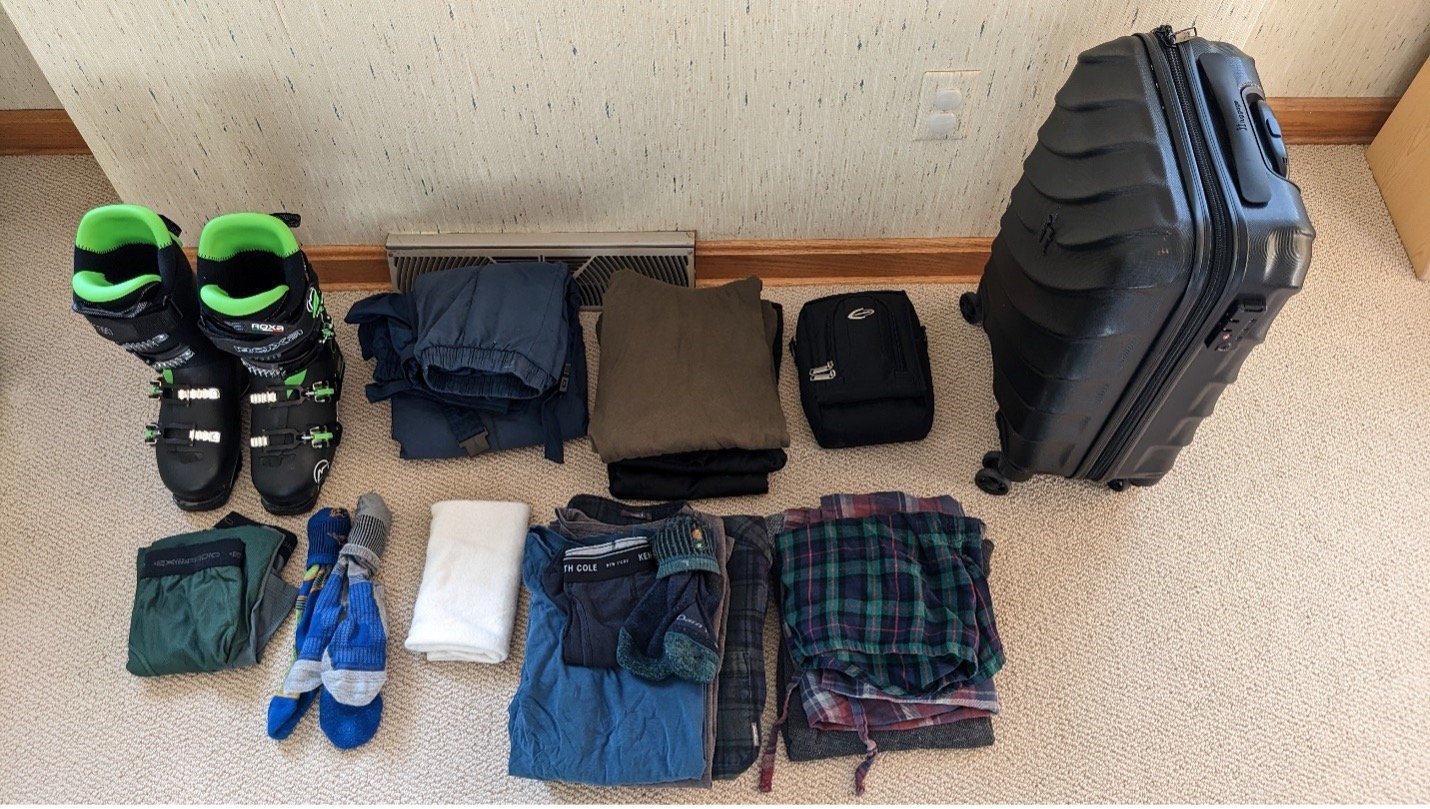Packing Light for a Ski Trip: A Full Demonstration of What to Do, And How to Do It
By Steven Reale
Planning to fly to a top-tier mountain resort this winter? Strategic packing can make transit easier and more efficient, save you money on baggage fees, and ensure that the most critical items for your trip arrive at the same time that you do. If you can manage to travel with carry-ons only, you can spare waiting for the checked bags to be unloaded. Here’s how I traveled to Telluride, Colorado for three days of skiing with only a backpack and a carryon suitcase.
From this…
…to this.
A full manifest of the items I brought appears at the bottom of this piece, but the eagle-eyed among you will have noticed that two important pieces of gear are missing from the previous photos. Yes, try as one might, carrying on your skis/poles or snowboard is, pardon the pun, not going to fly. In my case, I wanted to demo some skis while I was there. But even if you check your larger gear, consider carrying on your boots: if your checked luggage gets lost or delayed, it won’t be too difficult to find a satisfactory snowboard or pair of skis to rent; but if you own custom-fitted boots, you will never find rentals that compare. In addition, even though checking a boot bag often comes at no extra charge if already checking ski or board equipment, fitting your boots into a carry-on—and not having to bring that additional cumbersome piece of luggage—will save you a lot of hassle.
What to bring
My goal was to pack as efficiently as possible. This meant bringing as little as possible, and, wherever I could, finding ways to let articles serve double-duty. My first priority was my ski gear, and as you examine the manifest below, you’ll see that ski gear accounts for nearly half of the listed items. But I would need a coat and gloves even while I was off the slopes—no reason to bring a second set of these. I would of course want to change out of my ski clothing in the evenings, but if I showered after my day on the slopes and only wore an evening outfit for a few hours while out for dinner, I wouldn’t need more than two, and there was no reason why I’d need an extra, dedicated outfit to wear on the plane.
I wanted to be efficient, but I also wanted to be comfortable. I brought two sets of any kind of clothing that touched my skin directly, so that I could let one dry while I wore the other. While I could have lived without warm pajamas, they offered some welcome “après après” coziness while curled up in bed.
My advice is to start brainstorming your packing list early, so that over time you can add things as you think of them. Then, as you get closer to your trip, eliminate everything you can without overly sacrificing comfort. Your needs will likely be different from mine, but feel free to borrow (or steal!) my manifest for your own brainstorming.
How much can you bring?
The legacy carriers (e.g., United, American, and Delta) will generally allow you one free carry-on and one personal item. Budget airlines (e.g., Spirit, Frontier, JetBlue) often have more restrictive policies. Check with your carrier at booking so that you know in advance exactly what is included with your airfare. Still, I have never heard of an airline charging extra for a coat, and ski parkas are known to have many cavernous pockets…
For my trip, I flew on a legacy carrier, and divided my packing into three categories: articles in my backpack; articles in my carry-on; and articles I wore.
Articles in my backpack
Left to Right: Helmet, goggles, hydration pack, computer bag, water bottle, mid-layer jacket, backpack
The key to efficient packing is to start with the bulkiest objects. Find ways to fill their nooks and crannies, and decide where they will be packed first. My helmet is certainly large—there would be no way to cram it into my carryon suitcase, so, short of wearing it on the plane and attracting odd looks, my only other option was to put it in my backpack. The nice thing is: since I wasn’t wearing it, there was an entire head’s worth of space inside it, making it an ideal place to stash my goggles, which I could then be confident would be well protected from damage. The helmet lived in the bottom of the backpack, and the remaining articles fit in around it.
Goggles fit nicely into a helmet!
Packed…
… and zipped. One bag down.
Articles I wore
Left to right: Parka, trail mix, waterproof boots, gloves, hat, sunglasses, travel clothes, phone, wallet, earbuds, keys. Not pictured: sandwich and hard-boiled egg.
It was winter, and I live in Ohio: I needed my jacket to get to and from the airport anyway. May as well use its ample pockets for extra storage space! And, while I was at it, I made sure to travel in an outfit appropriate for wandering around a mountain town.
Articles in my carry-on
Left to right: Ski boots, two pairs of synthetic underwear, two pairs of ski socks, snow pants, neck gaiter, two pairs of base layers, evening clothes, toiletries, pajamas, suitcase
My boots being the bulkiest objects, they needed first consideration. As with my helmet, I might have attempted to wear them on the plane, but after some deliberation, I decided I’d try my best to avoid becoming a meme. As with the helmet, the boots offered two full feet’s and two full ankle’s worth of packing space—why let that go to waste? I stuffed the boots to the top, figured out which side of the suitcase would offer them the better fit, and packed the remaining articles in the other side.
Underwear, socks, and neck gaiter all found a home in my boots.
Carry-on is packed…
… and zipped. A bit janky, but it’s all in there. (At this point, I would have moved a few articles over to the backpack or my parka. There was still plenty of space there.) Everything is packed; off to the airport!
Conclusion
Walking through the airport with nothing but a backpack and a rolling carry-on made traveling a breeze, and it was great to arrive at my destination without needing to wait for a checked bag. More importantly, because I had planned ahead, there was nothing I felt was missing when I arrived.
So how did I do? Could I have packed even more efficiently? We’d love to hear your packing tips in the comments below.
Appendix—Full manifest
NOTE: You can support our content by using our Amazon affiliate links to the gear mentioned in the article! We may receive a commission if you buy the items linked.
ORGANIZED BY TYPE
Ski Gear:
· Parka* (Buy on Amazon)
· Gloves* (Buy on Amazon)
· Helmet (Buy on Amazon)
· Goggles (Buy on Amazon)
· Daypack (Buy on Amazon)
· Hydration pack (Buy on Amazon)
· Ski boots (Buy on Amazon)
· Snow pants
· Two sets of base layers
· Mid-layer jacket
· Two pairs of synthetic underwear (Buy on Amazon)
· Two pairs of ski socks (Buy on Amazon)
· Neck gaiter (Buy on Amazon)
Après-ski clothes:
· Parka* (Buy on Amazon)
· Gloves* (Buy on Amazon)
· Travel clothes
· Waterproof boots
· Hat
· One additional set of clothes
· Pajamas
Food and drink:
· Trail mix
· Water bottle
· Sandwich
· Hard-boiled egg
Miscellany:
· Toiletries
· Computer
· Sunglasses
· Phone
· Keys
· Earbuds
· Wallet
· Suitcase
An asterisk (*) indicates that the article is included under more than one type category.











